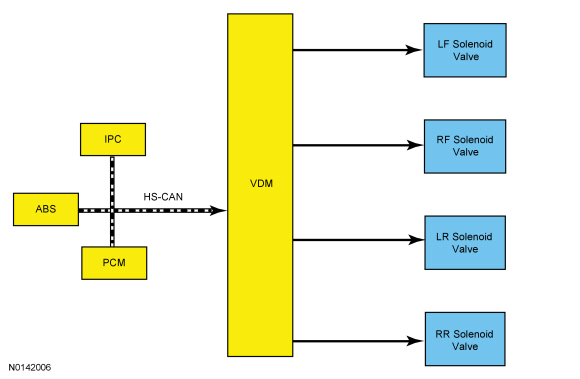SECTION 204-05: Vehicle Dynamic Suspension
| 2014 Mustang Workshop Manual
|
DESCRIPTION AND OPERATION
| Procedure revision date: 01/07/2013
|
Overview
The vehicle dynamic suspension allows the driver to select between 2 suspension modes; normal and sport. Normal mode is optimized for most street and daily driving. Sport mode is tuned to provide improved handling and stability.
System Operation

Network Message Chart
VDM Network Input Messages
| Broadcast Message | Originating Module | Message Purpose |
|---|---|---|
| Damper Mode Change Request | IPC | Communicates the driver selected suspension mode (Sport or Normal). The suspension remains in the requested mode, including key-off and key-on cycles, unless an override condition or fault exists. |
| ESC Damper State Request | ABS Module | Requests a specific suspension state from the VDM , which causes the state of the suspension to deviate from the driver selected mode. |
| Vehicle speed | PCM | Communicates vehicle speed in kilometers per hour. This signal is used by the VDM for certain override conditions. |
Vehicle Dynamic Suspension
The VDM is connected to the HS-CAN to communicate with the ABS module, the PCM and other systems. The VDM also monitors the solenoid circuits and sets DTCs when a concern with a circuit or a solenoid is detected. The ride control switch is hardwired to the PCM. Pressing the switch sends a signal to the PCM which then sends a message to the IPC over the HS-CAN . The IPC relays that message to the VDM and the VDM adjusts the valve solenoids as requested.
The two modes are Sport (off) and Normal (on). Normal mode is activated by applying constant voltage and varying the PWM duty cycle to get the desired current. When the current is applied, the solenoid magnet opens a sliding valve allowing fluid to flow through the "comfort" piston. This results in a more compliant (softer) suspension feel. Sport mode is activated by removing the voltage from the valve solenoid.
During an ESC event, the ABS module will send messages to the VDM over the HS-CAN requesting suspension adjustment to aid in maintaining vehicle stability. Also, the VDM will monitor vehicle speed and when a certain vehicle speed is achieved, the VDM will change to sport mode to aid in maintaining vehicle stability.
Component Description
Vehicle Dynamics Module (VDM)
The VDM monitors inputs and HS-CAN messages that relate to the vehicle dynamic suspension and then directly controls the valve solenoids. The VDM sends an individual electrical current to each valve solenoid to control the amount of damping required.
When a new VDM is installed, the module must be programmed with the vehicle configuration information. For additional information on module programming, refer to Section 418-01 .
Valve Solenoid
The valve solenoid is a PWM controlled solenoid that controls a sliding valve inside the damper.
Ride Control Switch
The ride control switch is a bank of 3 press and release switches, one is for suspension, one is for steering and one is for launch control.